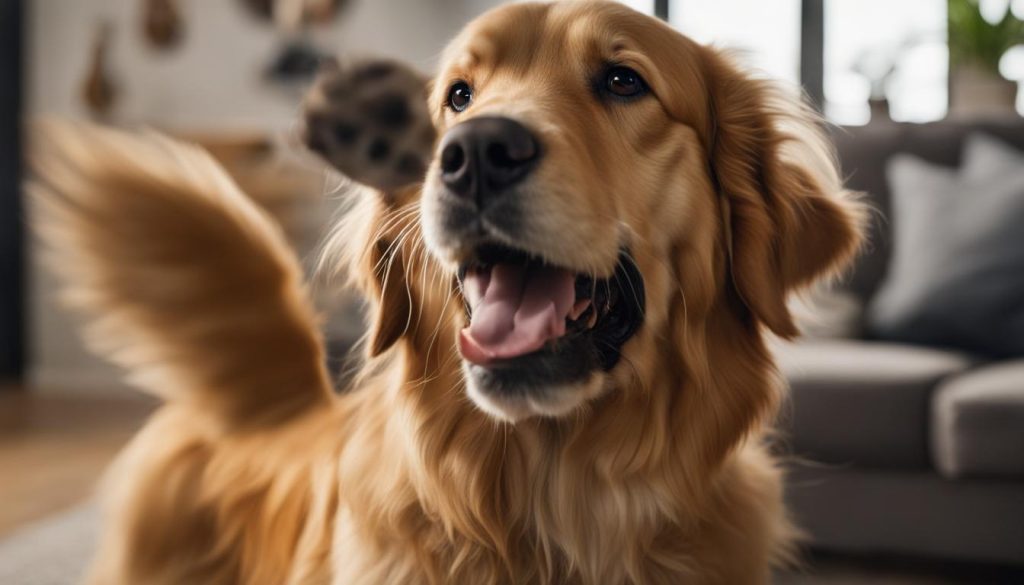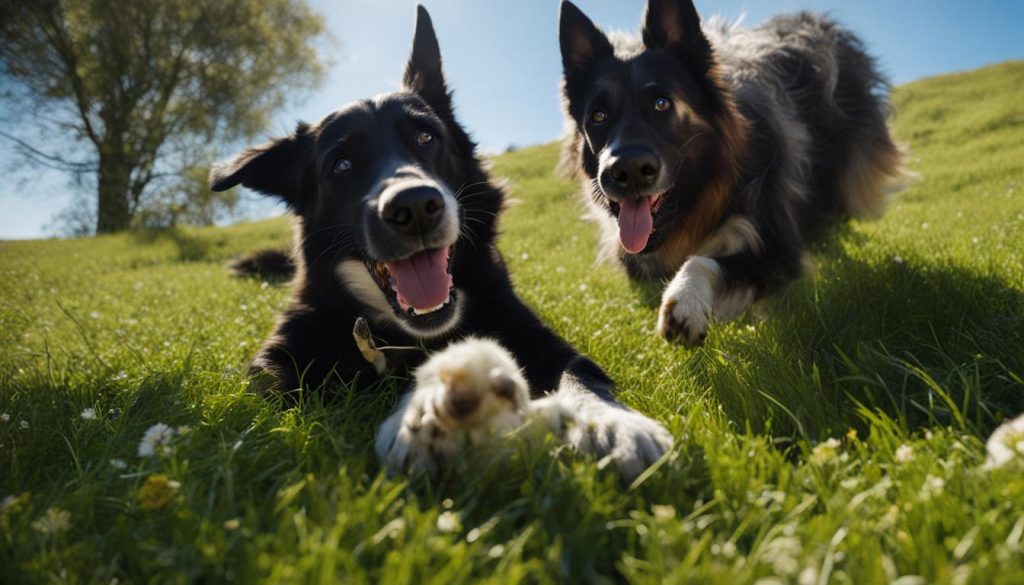I’m excited to share with you some of the easiest tricks that even beginners can teach their dogs. Teaching your dog tricks is not only a great way to bond with them but also a fun way to stimulate their mind. Whether you’re a seasoned dog owner or a first-timer, these tricks are sure to impress your furry friend.
Teaching your dog new tricks doesn’t have to be complicated or time-consuming. With the right approach and a little patience, you can have your dog performing these tricks in no time. Here are some easy dog training methods that will help you get started.
Key Takeaways:
- Teaching your dog tricks is a great way to bond with them and stimulate their mind.
- These tricks are suitable for beginners and dogs of all ages.
- Use positive reinforcement and be patient during the training process.
- Consistency and practice are key to mastering these tricks.
- Don’t forget to have fun and enjoy the learning experience with your dog!
Teach Your Dog to Shake Hands
Teaching your dog to shake hands is a basic yet impressive trick that can be easily mastered with some patience and positive reinforcement. This trick not only strengthens the bond between you and your furry friend but also showcases their intelligence and willingness to learn.
To begin, hold out your hand and offer a treat as an incentive. As your dog approaches and touches your hand with their paw, give a verbal command such as “shake” or “paw.” Once they make contact, reward them with the treat and offer verbal praise. Repeat this process several times until your dog understands the association between the command and the action.
Consistency is key when teaching this trick. Practice regularly and gradually phase out the treat rewards, replacing them with verbal praise and a pat on the head. With time, your dog will be able to shake hands on command, impressing everyone they meet!
“Teaching your dog tricks not only provides mental stimulation and entertainment, but it also strengthens the bond between you and your pet.”
Benefits of Teaching Your Dog to Shake Hands
Teaching your dog to shake hands can have several benefits. Apart from being a fun and impressive trick, it helps improve their focus and concentration. By learning to respond to a command and make physical contact with your hand, your dog enhances their communication skills and obedience.
Furthermore, teaching your dog this basic command can come in handy in various situations. When greeting new people or in social gatherings, your dog’s ability to shake hands politely can make a positive impression. It also helps redirect their attention during times of excitement or anxiousness, providing them with a positive outlet for their energy.
| Benefits of Teaching Your Dog to Shake Hands |
|---|
| Improves focus and concentration |
| Enhances communication skills and obedience |
| Makes a positive impression during greetings and social interactions |
| Provides a positive outlet for energy |
Teaching your dog to shake hands is a rewarding experience that strengthens the bond between you and your furry companion. With consistent training and positive reinforcement, your dog will quickly learn this cool trick and impress everyone with their paw-shaking skills!

Teach Your Dog to Speak
When it comes to simple dog training tricks, teaching your dog to speak can be both fun and effective. This quick dog training technique is a great way to engage your furry friend and encourage their vocalization skills. Here’s how you can teach your dog to speak:
- Start by making a barking sound yourself to grab your dog’s attention. You can use phrases like “speak” or “talk” to associate the vocalization command with the trick.
- As soon as your dog makes a noise, reward them with a treat and praise. Positive reinforcement is key to effective dog training.
- Repeat this process multiple times, gradually phasing out your barking sound and relying solely on the verbal command. Make sure to reward your dog every time they successfully bark on command.
Consistency is key when training your dog to speak. Practice the trick regularly in short sessions to reinforce the behavior. Don’t forget to stay patient and positive throughout the training process.
| Benefits of Teaching Your Dog to Speak | Challenges of Teaching Your Dog to Speak |
|---|---|
| – Provides mental stimulation | – Some dogs may be naturally more vocal than others |
| – Strengthens the bond between you and your dog | – Requires consistent practice and reinforcement |
| – Can be useful to get your dog’s attention | – May take time for some dogs to learn the command |
From experience, every dog is different, and some may pick up the trick more quickly than others. Don’t get discouraged if your dog doesn’t start barking on command right away. With time, patience, and positive reinforcement, they will eventually learn to speak!
Why Teach Your Dog to Speak?
Teaching your dog to speak is not just a fun party trick; it also has practical benefits. By learning to vocalize on command, your dog can help alert you to potential dangers or intruders. Furthermore, this trick can provide mental stimulation and help prevent boredom in your furry companion.

Teach Your Dog to Back Up
When it comes to dog training tricks, one that is both fun and useful is teaching your dog to back up. This simple command can come in handy in everyday situations, such as when you need your dog to create distance from something or someone. Here’s how you can teach your dog to back up:
- Start by holding a treat in front of your dog’s nose and slowly move it away from them. This will encourage them to take a few steps back.
- As your dog starts to back up, use a verbal command such as “back up” or “step back.” This will help them associate the command with the action.
- Once your dog has taken a few steps back, reward them with the treat and praise. Positive reinforcement is an effective way to reinforce the desired behavior.
- Repeat this process several times, gradually increasing the distance your dog backs up each time. Eventually, they will understand the command and be able to back up on command without the need for a treat.
Consistency is key when training your dog, so be sure to practice this command regularly. Start with short training sessions and gradually increase the duration as your dog becomes more comfortable with the command. Don’t forget to always use positive reinforcement and reward your dog for their efforts.
Table: Progress Tracker for Teaching Your Dog to Back Up
| Training Session | Command | Distance Backed Up | Reward |
|---|---|---|---|
| Session 1 | “Back up” | 1 step | Treat + Praise |
| Session 2 | “Back up” | 2 steps | Treat + Praise |
| Session 3 | “Back up” | 3 steps | Treat + Praise |
| Session 4 | “Back up” | 4 steps | Treat + Praise |
With patience and consistent training, your dog will soon master the back up command and be able to create distance on command. Don’t forget to always keep the training sessions positive and enjoyable for both you and your furry friend.
Teach Your Dog to Wave Hello
Teaching your dog to wave hello is a fun and adorable trick that is sure to impress your friends and family. It’s also a great way to add some variety to your dog’s repertoire of tricks. To teach your dog to wave hello, you can build upon the foundation of teaching them to shake hands.
Start by holding out your hand and giving the command “shake” or “paw” that your dog is familiar with. When your dog lifts their paw to shake, raise your hand slightly higher, almost as if you’re asking for a high-five. At the same time, give the command “wave” and wait for your dog to lift their paw again. As soon as they lift their paw, reward them with a treat and lots of praise.
Repeat this process several times, gradually using the command “wave” without the hand gesture. Eventually, your dog will associate the verbal command with the action of lifting their paw. Be patient and consistent in your training sessions, and remember to always reward your dog for their efforts.

Benefits of Teaching Your Dog to Wave Hello
Teaching your dog to wave hello not only adds a cute and amusing trick to their repertoire, but it also has several benefits. First and foremost, it strengthens the bond between you and your furry friend. Training together builds trust and communication.
Additionally, teaching your dog tricks like waving hello helps to stimulate their mind and prevents boredom. Dogs are intelligent creatures that thrive on mental stimulation, and learning new tricks provides them with the mental exercise they need.
Lastly, teaching your dog to wave hello can also be a great way to impress guests and show off your dog’s skills. It’s a fun and entertaining trick that will surely bring a smile to everyone’s face.
Teach Your Dog to Spin
Teaching your dog to spin is a fun and impressive trick that will surely amaze your friends and family. Not only is it a great way to showcase your dog’s intelligence and agility, but it also provides mental stimulation and exercise. By following a few simple steps, you can easily teach your dog to spin on command.
To begin, hold a treat near your dog’s nose and slowly move it in a circular motion. Encourage your dog to follow the treat with their nose, guiding them to complete a full spin. As they do so, use a verbal command such as “spin” or “turn.” Once your dog completes the spin, reward them with the treat and plenty of praise.
Consistency is key when teaching your dog to spin. Practice this trick in short sessions, multiple times a day. Gradually reduce the use of treats, relying more on verbal commands and praise as your dog becomes more proficient. Don’t forget to always end each training session on a positive note, acknowledging your dog’s progress and effort.
| Steps to Teach Your Dog to Spin |
|---|
| 1. Hold a treat near your dog’s nose |
| 2. Slowly move the treat in a circular motion |
| 3. Encourage your dog to follow the treat with their nose |
| 4. Use a verbal command such as “spin” or “turn” |
| 5. Reward your dog with a treat and praise |
| 6. Practice regularly and gradually decrease the use of treats |
From experience, teaching your dog to spin requires patience and positive reinforcement. Each dog learns at their own pace, so be sure to tailor the training to your dog’s needs. With consistent practice and a little bit of fun, your dog will master this cool trick in no time.

- Get into position: Hold a treat above your dog’s head and guide them into the begging position while giving a verbal command.
- Reward and repeat: Give your dog the treat and praise them when they successfully assume the begging position. Repeat the process, gradually increasing the duration they stay in the position.
- Be patient and consistent: Dogs learn at their own pace, so be patient and consistent with your training to achieve the best results.
Teach Your Dog to Roll Over
Teaching your dog to roll over is a classic trick that can be a bit more challenging. It requires patience and consistency, but with practice, your dog can master this impressive trick. Here’s a step-by-step guide on how to teach your dog to roll over.
1. Start by getting your dog to lie down. Use a verbal command such as “lie down” and reward them when they assume the position. This will be the starting position for teaching the roll over.
2. Hold a treat close to your dog’s nose and slowly move it in a circular motion, guiding them to roll onto their side. Use a verbal command such as “roll over” as you guide them. Reward them with the treat and praise when they complete the roll.
3. Repeat this process several times, gradually reducing the amount of guidance with the treat. Eventually, your dog should be able to roll over with just the verbal command.
| Steps to Teach Your Dog to Roll Over |
|---|
| 1. Get your dog to lie down |
| 2. Hold a treat close to their nose and guide them to roll over |
| 3. Repeat the process and gradually reduce guidance |
Don’t forget to be patient and use positive reinforcement throughout the training process. It’s generally advisable to take small steps and gradually build up to the full roll over motion. Practice this trick in short training sessions and be sure to reward your dog’s progress with treats and praise.
Teaching your dog to roll over not only impresses others, but it also provides mental stimulation and strengthens the bond between you and your furry friend. Have fun with the training process and enjoy seeing your dog master this cool trick!

Final Thoughts
Teaching your dog tricks is a fun and rewarding experience for both you and your furry friend. These easy tricks can be taught to dogs of all ages, providing mental stimulation and strengthening the bond between you and your pet. By using positive reinforcement and staying consistent with your training, your dog will quickly master these beginner tricks.
Whether it’s teaching your dog to shake hands, speak, back up, wave hello, spin, beg, or roll over, these tricks are a great way to engage your dog’s mind and keep them entertained. With easy dog training methods, even beginners can successfully train their dogs to perform these fun and impressive tricks.
Don’t forget to be patient throughout the training process. Dogs learn at their own pace, so it’s important to stay positive and encouraging. By consistently practicing these tricks with your dog, you’ll soon see progress and be amazed at what they can do.
So grab some treats, get ready to have some fun, and start teaching your dog these beginner tricks today. You’ll not only create a stronger bond with your furry companion but also provide them with mental stimulation and a sense of accomplishment. Happy training!
FAQ
What are some easy tricks to teach my dog?
Some easy tricks to teach your dog include shaking hands, speaking, backing up, waving hello, spinning, begging, and rolling over.
How do I teach my dog to shake hands?
To teach your dog to shake hands, hold out your hand and offer a treat. Use a verbal command such as “shake” or “paw.” When your dog touches your hand with their paw, reward them with the treat and praise.
How do I teach my dog to speak?
To teach your dog to speak, make a barking sound and use a verbal command such as “speak” or “talk.” Reward your dog with a treat and praise when they make a noise.
How do I teach my dog to back up?
To teach your dog to back up, hold a treat in front of their nose and slowly move it away, encouraging them to back up. Reward them with the treat when they take a few steps back.
How do I teach my dog to wave hello?
To teach your dog to wave hello, start by teaching them to shake hands. Then, raise your hand slightly higher and use a verbal command such as “wave.” Reward them with a treat and praise when they lift their paw.
How do I teach my dog to spin?
To teach your dog to spin, hold a treat near their nose and slowly move it in a circle, encouraging them to follow it with their nose. Use a verbal command such as “spin” and reward them with the treat when they complete the spin.
How do I teach my dog to beg?
To teach your dog to beg, hold a treat above their head and encourage them to lift their front paws. Use a verbal command such as “beg” and reward them with the treat when they assume the begging position.
How do I teach my dog to roll over?
To teach your dog to roll over, start by getting them to lie down. Then, hold a treat close to their nose and slowly move it in a circular motion, guiding them to roll over. Use a verbal command such as “roll over” and reward them with the treat when they complete the roll.
Why is teaching tricks to my dog beneficial?
Teaching tricks to your dog is beneficial because it provides mental stimulation, strengthens the bond between you and your pet, and allows you to have fun together.






